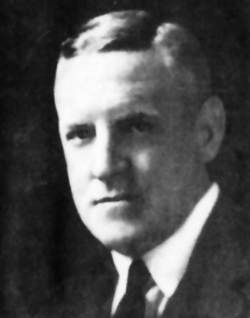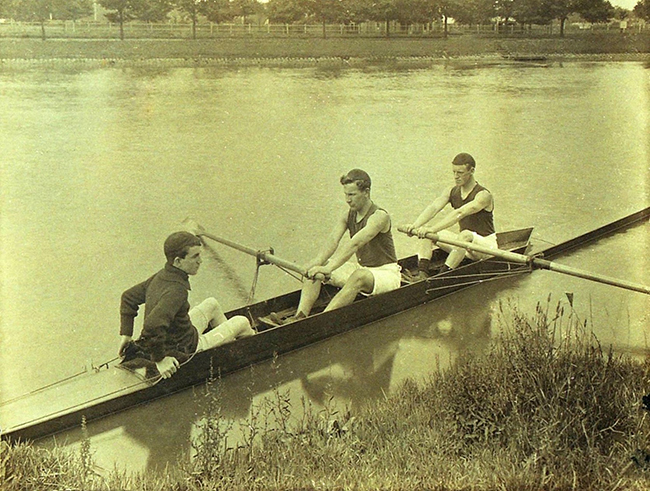COL George I Stevenson CMG DSO VD

Yarra Yarra Rowing Club (VIC)
George Ingram Stevenson (1882-1958)
A veteran of the Boar War, after which he joined Yarra Yarra and held positions of secretary and committee, also treasurer of the Victorian rowing association. He entered and won a number of races in this period.
On declaration of WW1 he enlisted to serve with a distinguished career. He remained in the army until the mid-1930s. Before starting his own accountancy firm “G I Stevenson & Co”, he also re-joined Yarra Yarra at the end of WW1 to serve on the committee, then as vice president followed by the president’s position for 18 years (our longest serving president), he happened to be president during the second world war until he was elected to the patron’s position.
There was a practice eight named in his honour after the 1929 fire. There is no indication that he competed after WW1, In the club races held in the 1930’s there were G I Stevenson pairs on the calendar, some of the trophies that were competed for are on display in our trophy cabinet.
A clock in the trophy cabinet bottom shelf right hand side was a wedding present from the club, a club badge mounted on the front has since been removed. This clock was not appreciated by the family it was returned to the club.
Rowing record
1905 - Seymour Regatta, Maiden Pair, bow - First
1906 - Colac Regatta, Junior Four, bow seat - First
1906 - Colac Regatta, Maiden Four, bow seat - First
1909 - Geelong and Barwon Regatta, Junior Eight three seat - First
1906 - Upper Yarra Regatta, Senior Eight, five seat - First
1908 - Army Challenge Cup, Australian Field Artillery, five seat - First
1949 - Elected Patron of Yarra Yarra Rowing Club.
E J H Howard wrote the following biography of COL Stevenson in the Australian Dictionary of Biography in 1990.
George Ingram Stevenson (1882-1958), soldier and chartered accountant, was born on 8 March 1882 at Kelvinside, Lanarkshire, Scotland, son of George Stevenson, colliery cashier, and his wife Margaret Ann, née Ingram. The family came to Australia in 1888 and George was educated at Brunswick College, Melbourne. He served in the South African War with the Prince of Wales Light Horse and the 4th Battalion, Australian Commonwealth Horse, and was awarded the Queen's Medal with five clasps. Enlisting subsequently in the (volunteer) Garrison Artillery in Victoria, he was commissioned in the Australian Field Artillery on 20 September 1909 and became captain in 1912. He had qualified as a chartered accountant in 1909, went into practice in 1911 and was to establish the accountancy firm of G. I. Stevenson & Co. in Melbourne in 1933.
Shortly after the outbreak of World War I he joined the Australian Imperial Force and was posted to the 2nd Field Artillery Brigade as a captain. He embarked in October 1914 with the 6th Field Battery, landed on Gallipoli on 25 April 1915, and in May was promoted major and appointed battery commander. In an action on 14 November 1915 he directed the fire of one of his guns while its shells just cleared his head. Mentioned in dispatches, he was appointed C.M.G. for his Gallipoli service.
In March 1916 Stevenson was promoted lieutenant-colonel with command of the 21st Howitzer Brigade; he was mentioned in dispatches for consistent good work as a brigade commander and for meritorious service at Pozières, France. Given charge of the 2nd Field Artillery Brigade in January 1917, he commanded the group of artillery in the Lagnicourt Valley on 15 April 1917 at the time of the German breakthrough. The guns of all four batteries of the 2nd Field Artillery Brigade had to be abandoned, but their breech-blocks and dial-sights were removed by the retreating Australians. He later commanded the re-equipped brigade at the 3rd battle of Ypres and was again mentioned in dispatches for his skill and coolness.
Appointed in August to command the 3rd (Army) Field Artillery Brigade, by September 1918—during the attack on the Hindenburg outpost line—he had charge of the Left Artillery Group consisting of four artillery brigades. Stevenson was awarded the Distinguished Service Order in September 1918, the citation reading: 'This officer has commanded his brigade in the most able and efficient manner during the whole of the operations carried out by this [Australian] Corps since coming on the Amiens front. His brigade has been continuously in action and has constantly moved from one part of the front to the other. He frequently commanded large groups of brigades of artillery for active offensive operations and on occasions under the most trying conditions … His fearless courage under shell fire has been the means of maintaining the high morale that exists in his brigade.'
Embarking for Australia on Anzac leave in October 1918, Stevenson was discharged from the A.I.F. in February 1919; he was reappointed in May as officer commanding troops on transports and returned to Australia in January 1920. In July he temporarily commanded the 8th Field Artillery Brigade, Australian Military Forces, and was then given charge of the 22nd Field Artillery Brigade. In 1922-27 he was Commander Royal Artillery, 3rd Division, A.M.F., with the rank of colonel, and in 1931-35 commanded the 10th Infantry Brigade.
After demobilization Stevenson had resumed work as an accountant. On 30 May 1923 he married Frances Clare Dennis (d.1931) with Anglican rites at Christ Church, South Yarra, Melbourne. They were to have a son and daughter. On 22 December 1936 he married a widow, Hilda Mabel Kidd, daughter of H. V. McKay, at Toorak Presbyterian Church. Survived by his wife (D.B.E., 1968) and by the children of his first marriage, he died in East Melbourne on 11 July 1958 and was cremated. His son, Major General John Dennis Stevenson, A.O., C.B.E., served in Korea and Vietnam.
The further information was supplied by Jim Skidmore in June 2024.
Member 194/05 - 1958/59
Colonel G I Stevenson was:-
Secretary 1904-05 & 1905-06 seasons.
Honorary Auditor 1922/23---1925/26
President of YYRC from 1931/1932 until 1948/49.
When he became patron until his death in 11-7- 1958.
There was a practice eight named in his honor after the 1929 fire.
Wins recorded:-
1905 - Seymour regatta, maiden pair (bow)
1906 - Colac regatta, junior four (bow)
1906 - Upper Yarra regatta, maiden eight (5)
1908 - Army challenge cup, Australian field artillery crew (5)
1909 - Geelong & Barwon regatta, junior eight (3)
In 1929 after the fire a practice eight was named in his honour.

1905 Maiden pair Seymour regatta George Stevenson bow seat
From 1948-49 annual report:-
The year 1899 can certainly be placed on record as being a memorable one for the Yarra Yarra rowing club.
In that year of yesterday a young lad, who later was to establish a brilliant record of service and devotion to his club and sport, joined the novice ranks of the Cardinal and Navy Blue. He was Colonel George Ingram Stevenson, C.M.G, D.S.O, V.D.. President of Yarra Yarra rowing club.
Winning his maiden and junior races early in his rowing career, his training was interrupted by the great war of 1914-18 for which he laid aside his rowing togs and donned the uniform of a soldier. Though 12,000 miles away in the fields of Flanders, his genuine intrest in the welfare of his club back home helped the remaining half-dozen members to battle on and keep Yarra Yarra’s head above water .
Emerging from World War 1 with richly earned decorations and the distinguished rank of colonel, George Stevenson resumed active membership with his club and sport. Ex- Treasurer of the V. R. A. and our representative on the Henley Committee for a number of years, Col. Stevenson has held practically every office in the club, and this year will retire from the Presidency after 18 years continuous service in that position. It is indeed fitting that upon this occasion he should also complete his fiftieth year with us.
We are truly indebted to him for the work he has done for this club and the sport in general and we are happy to note his intention of keeping up his active interest in our affairs. Congratulations, Colonel Stevenson from all fellow members of Yarra Yarra!
From 1958-59 YYRC annual report:-
It is with deep regret we record the passing of Colonel G.I.Stevenson.
Colonel Stevenson was the Patron and President of Yarra Yarra rowing club for many years and by his death, the club and the sport of rowing has suffered a severe loss.
Our sincere sympathy is extended to his family.
From the 1971/72 annual report:-
Colonel George Stevenson had a distinguished military career and was active with rowing administration, including an Army Rowing Association.
From YYRC newsletter 'Yarra Yabbie' no10, 1984-3-20
Personalities one associates with Yarra over a very long period, which has been a strong point of the club.
Connel G.I. Stevenson, held office of president for many years, also that of patron, was a fine clubman with a distinguished military career and an active record in rowing administration.
From the YYRC newsletter 'Yarra Yabbie' 2005-5-20
Rowing Snippets
Discipline in rowing
Thanks to Yarra member Peter Gill who forwarded an enlightening article from the Winner newspaper of 10/8/1914.
A chap by the name of George Ingram Stevenson came to YYRC in 1899 and was a member for more than 50 years. As a correspondent for the Winner newspaper, he wrote a piece about serving in the Boar war.
Commenting on rowers make excellent militia-men, G I Stevensen wrote (and I’m sure it’s true for women!).
It is often remarked by people on the bank, when they hear the shrill voice of a coxswain in unmistakable tone of command, telling a full-grown man to do something which he is trying his hardest to accomplish, that it is a wonder the man stand being bossed about by a boy. It is a wonder, but it is he discipline of the sport that makes a man do it!’.
Jim Skidmore and Andrew Guerin
April 2022 (updated in June 2024 with further information from Jim Skidmore)
Sources:
- E. J. H. Howard, 'Stevenson, George Ingram (1882–1958)', Australian Dictionary of Biography, National Centre of Biography, Australian National University, https://adb.anu.edu.au/biography/stevenson-george-ingram-8655/text15113, published first in hardcopy 1990, accessed online 17 April 2022.
- Jim Skidmore's records
- The Victorian Oarsman and Rowing Register by John Lang, published by A H Massina and Co, Melbourne 1919

